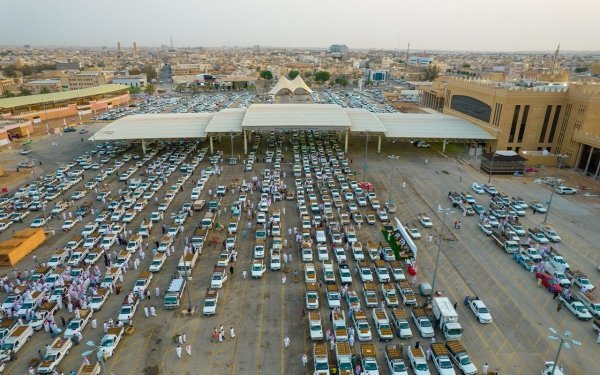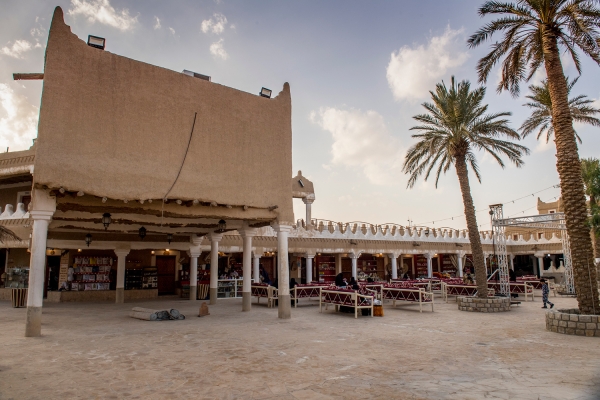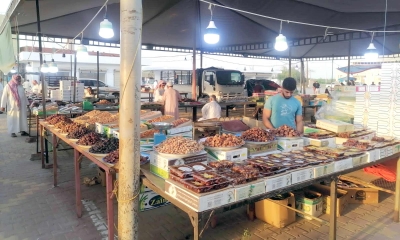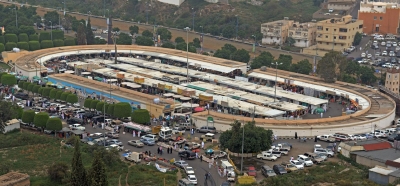


Traditional Markets in Qassim Province are commercial shops located in Qassim Province in the heart of the Kingdom of Saudi Arabia. These markets follow the Qaisariya style, which features open shops arranged around a central courtyard surrounded by an arcade for cultural activities traditionally associated with these markets. The Qaisariya style includes a main entrance and subsidiary entrances. The shops can be interconnected on three sides, with the fourth side serving as an independent entrance to the market.
Traditional markets in Buraydah
Old markets of Buraydah are among the most prominent traditional markets frequented by people in Qassim Province. Notable markets include Souqal-Olayan, al-Qadi, and al-Mahharish, as well as Souq al-Jarda and al-Wasaa near the Great Mosque, which was later named King Fahd Mosque. Al-Jarda Square, located east of the mosque, was one of the famous squares in old Najd towns, containing various types of commercial goods alongside Dahis and Ibn Rashid's dome.
Some markets specialized in selling spices, herbs, and traditional medicines, while others were dedicated to the trade of feed such as alfalfa, barley, and hay. Additionally, there were markets for selling food items like flour, corn, and barley, with rice, tea, and coffee being added in later times.
Buraydah historically gained commercial significance due to its diverse local agricultural and industrial products, with people skilled in woodworking, tanning, saddlery, construction, traditional crafts, and the buying and selling of bisht.
The prominent role played by the traders known as al-Aqilat had a significant impact on developing and flourishing local trade through their journeys to the Levant, Iraq, and Sudan, bringing various goods such as clothing and essential food items.
Buraydah Date Festival
Date shops in Buraydah City typically experience a significant boost in sales and a bustling market activity from consumers, coinciding with the launch of the Buraydah Date Festival, the largest economic event for dates in the Kingdom. Every year, Qassim Province transforms into a marketplace for selling various types of dates, with more than forty-five varieties available, including Sukkari, al-Khalas, Segae, Shaqra, Hashaishee, Ruthan, Maktomi, and Wanana, among others.
Al-Musawkaf Traditional Market
Qassim Province hosts al-Musawkaf Traditional Market in the heart of Unayzah Governorate, one of the prominent markets in Najd region. Originally demolished in 1968, the market was rebuilt in the old style and reopened by the Governor of Unayzah during a tourism festival in 2009. It was inaugurated by the Governor of Qassim in 2010, with the Antiquities and Museums Unit of Unayzah overseeing its execution.
The market comprises fifty-two shops for men and women, rented at symbolic prices. Built in the old style, these shops include all traditional handicrafts, providing more than one hundred job opportunities. The design incorporates all architectural elements of old shops (Dakakin), with a surrounding arcade designed in the traditional style. The market also features "Dughaitheriya Station," a historic gathering point for travelers, showcasing vehicles and buses used for passenger transport.
Public auctions are held in the market for utensils, antiques, heritage items, and old swords. Additionally, the market hosts annual tourism festivals and events, including shows, religious and social competitions, folklore poetry and songs presented by the Culture and Arts Committee, a parade of old cars, and various traditional children's games.
Al-Hanaini Festival at al-Musawkaf Traditional Market
In 2022, al-Musawkaf Traditional Market in Unayzah hosted the sixth edition of 'al-Hanaini Festival.' The festival aims to support productive families and male and female entrepreneurs, and promote al-Hanaini, a traditional winter dish made from dates. Hanaini is well-known in Qassim for its delicious taste and economic benefits for productive families.
Souq al-Majlis in al-Midhnab
The old market, 'Souq al-Majlis', in al-Midhnab Governorate is one of the landmarks of the ancient town, located to the east of Bahla Palace, which dates back to the sixteenth century.
The market continued its commercial activities over the centuries until urban development led residents to move to other neighborhoods, and new markets emerged, attracting traders and consumers. Nowadays, the market is mainly active on Fridays when an auction is held after the prayer, drawing people to buy and sell.
Souq al-Majlis area offers an opportunity for trading heritage items through its various shops and presents a real investment opportunity in architectural heritage. It regularly attracts visitors, tourist delegations, and those interested in ancient relics. Additionally, the market provides potential for investment in traditional restaurants and the sale of antique items.
Reconstruction of traditional markets and heritage villages
In 2011, the (former) Saudi Commission for Tourism and Antiquities undertook the reconstruction of several traditional markets and heritage villages. This included the rebuilding of al-Khobar Heritage Village, Souq al-Majlis in al-Midhnab, and al-Musawkaf Market in Unayzah City. Additionally, they oversaw the reconstruction of Bayt al-Hamdan and other heritage villages in Buraydah and various governorates in Qassim Province. The projects involved many skilled elderly craftsmen and teams of young workers to preserve the heritage and landmarks of the province.
Related quizzes

